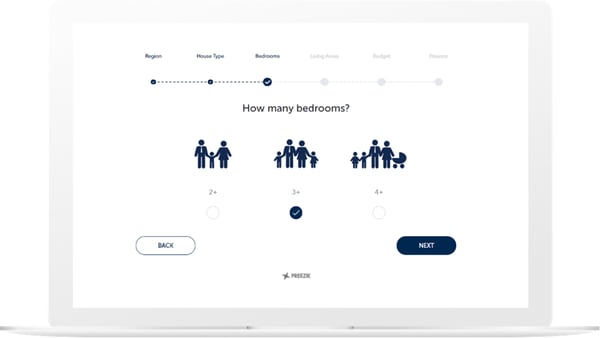What is a product recommendation engine?
A product recommendation engine is a system that take inputs, cross references those inputs to products within a database and recommends the most suitable options. In other words, it’s a method to filter down product choices.
Think about the last time you purchased a TV, Dishwasher, Fridge, Shoes, Shaver, House, Car, etc. Did you speak with a sales assistant? Did she/he provide a recommendation on what product would best suit you? Chances are you did, and they did. That is another example of a product recommendation engine (only the engine is a human brain). Nowadays given the improvement in technology we can start to replicate that function online, hence the term “product recommendation engines”.
What kinds of product recommendation engine are there?
There are many different types of recommendation engines out there in the market. Ultimately, they can be manual or automatic, they can consider user inputs or customer behaviour. They can have aspects of machine learning, therefore can improve over time. However, I like to break down them down into two different types. Passive and Interactive.
Passive recommendation engines: This refers to engines that learn from consumer behaviour and have algorithms built to handle generic information. These would be typically less accurate however require no user input. I call these systems passive as you often don’t even know they are there. They sit in the back, learn and often show up as a “You may also like…”. For example, Netflix has a passive recommendation engine. Shows that appear in your Netflix are typically determined by a passive recommendation engine that has learnt your preferences over time.
Interactive recommendation engines: As the name suggest these are interactive, meaning that the system asks the user questions and receives answers. These answers are inputs for the product recommendation. For example, you may ask what your budget is, and get a response of $1,000. Passive engines would make a assumption up based on your browser history, hence passive is more a assumption, where interactive is a known fact. These systems can have an element of machine learning also and can even include an element of passive engines, however in general the fundamental operations are slightly different. These are more like real life sales assistants. Its all about asking the right questions and understanding the correct metrics so the algorithm can make the best recommendations. Preezie’s current product offering is interactive recommendation engines.

What is the difference between a standard filters and a product recommendation engine?
Sometimes customers don’t know the difference between a filter and a recommendation engine. In particular an interactive recommendation engine as they ask questions and get user inputs similar to filters.
Filters are simply put “binary”, they are “yes” or “no”. Where product recommendation engines like Preezie’s are built off mathematical algorithms that numerically calculate how well a product matches your specific requirement. An important note is that algorithms and our engines can closely emulate a real-life sales person or process, filters cannot.
Let’s go through an example, imagine your looking for a new washing machine. You obviously have a few specific requirements for your washing machine. Let’s assume your specific circumstances are:
- Live in a home of 5 people (means 7kg+)
- Have a budget of $1,000
- Preference for Stainless Steel
- Want a gentle wash (your last washing machine ripped your shirts, example Front Loader)
A filter would look for each one of those specs individually and show results if they all matched. For example, if there was a washing machine that matched all those specifics but was $1,020 dollars a filter would not show you this. Or let’s say there was a washer that matched all those specifics but was “Platinum Steel”, once again a filter would not show you this. On the other hand, let’s pretend there was 20 washers that matched all those criteria’s, a filter would show you all 20 and that doesn’t really help you figure out which one is best.
With an interactive recommendation engine like Preezie’s the customer would see a list of 3,6 or 9 (typically max) products that best match their requirements. In the example where all specs match but the washer is $20 over budget, our recommendation engine would know this, understand how important overbudgets are and give that product a score, typically in that scenario given the small overbudget amount it would be ranked very highly.
The difference ultimately is that filters don’t rank products, they just tell you what matches the specific fields, whereas a recommendation engine actually ranks and scores products numerically, so you have an informed list of best matching products.
Where do you use product recommendation engines?
Some suggest recommendation engines are suitable for virtually all products. However, I tend to disagree. In particular interactive product recommendation engines I believe have a specific use case.
If the answer to the below question are “yes” then I believe technology like Preezie is well suited for your business:
1. Do you want to increase conversions online? Either sales or leads? Trick question 😉
2. Do you have a large product range (more then 10-15 products)?
3. Do you have enough traffic to warrant a system (more then 5,000-10,000 hits per month)?
4. Is your product a considered purchase?
Advantages of recommendation engines?
So, what are the advantages of product recommendation engines. There are several pros to having an engine like Preezie’s on your website, both tangible and intangible benefits. These include:
1. Increase e-commerce and lead generation conversion online
2. Provide better customer engagement and experience
3. Business insights (real time market surveys)
4. Reduce the time to find a suitable product
Below is a snapshot of a business Porter Davis that is using our engine. As they say the proof is in the pudding.

If you want to know more about recommendation engines and Preezie please book in a time to chat below.
Other blogs you might be interested:
1. What is guided conversion and why all eCommerce managers should care

